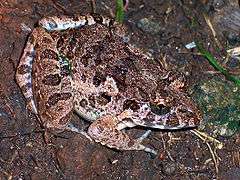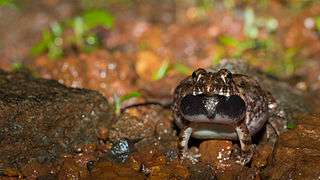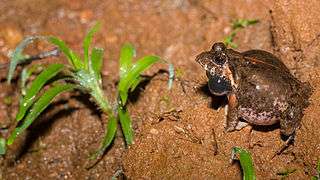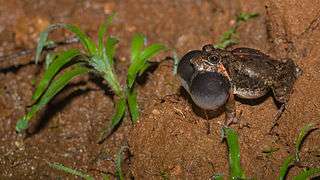Fejervarya
| Fejervarya | |
|---|---|
 | |
| Crab-eating Frog (Fejervarya cancrivora), one of the "true" Fejervarya | |
| Scientific classification | |
| Kingdom: | Animalia |
| Phylum: | Chordata |
| Class: | Amphibia |
| Order: | Anura |
| Family: | Dicroglossidae |
| Subfamily: | Dicroglossinae |
| Genus: | Fejervarya Bolkay, 1915 |
| Type species | |
| Rana limnocharis Gravenhorst, 1829 | |
| Diversity | |
| 16 species, but see text | |
| Synonyms | |
|
Minervarya Dubois, Ohler & Biju, 2001 | |
Fejervarya is one of the Asian genera of frogs in the Dicroglossidae family. First proposed in 1915 by István József Bolkay, a Hungarian naturalist, the genus did not see widespread adoption at first. As late as the 1990s it was generally included in Rana, but more recent studies have confirmed its distinctness.
These frogs are remarkable for being extremely euryhaline by amphibian standards. Species such as the crab-eating frog (F. cancrivora) can thrive in brackish water, and its tadpoles can even survive in pure seawater.[1]
Systematics and taxonomy

Fejervarya was first introduced as subgenus of Rana and later placed as subgenus as Limnonectes. It was treated as an independent genus first in 1998. However, Fejervarya sensu lato was found to be paraphyletic with respect to Sphaerotheca. This issue was eventually resolved in 2011 by splitting off Zakerana from Fejervarya. Fejervarya, as now defined, is distributed from eastern India (Orissa) eastwards through Myanmar to southern China and Indochina to the islands of the Sunda Shelf as well as Japan.[2] In contrast, Zakerana contains species from southern Asia (Sri Lanka and Indian subcontinent including Pakistan, Nepal, and Bangladesh)[3]
The widespread Cricket Frog (F. limnocharis) and some others have also been suspected to be cryptic species complexes since at least the 1970s, and indeed a few populations have been identified that almost certainly constitute undescribed species.[4][5]
Vocalisation behaviour
 1. Preparing to vocalise - front view
1. Preparing to vocalise - front view 2. Vocalising front view
2. Vocalising front view 3. Preparing to vocalise - side view
3. Preparing to vocalise - side view 4. Vocalising side view
4. Vocalising side view
Species
Fejerverya sensu stricto contains 16 described species,[2] as well as some putative but undescribed species:[2][4][5]
- Fejervarya andamanensis (Stoliczka, 1870)
- Fejervarya cancrivora (Gravenhorst, 1829)
- Fejervarya gomantaki [6]
- Fejervarya iskandari Veith, Kosuch, Ohler, and Dubois, 2001
- Fejervarya kawamurai Djong, Matsui, Kuramoto, Nishioka, and Sumida, 2011
- Fejervarya limnocharis (Gravenhorst, 1829)
- Fejervarya modesta (Rao, 1920)
- Fejervarya moodiei (Taylor, 1920)
- Fejervarya multistriata (Hallowell, 1861)
- Fejervarya nicobariensis (Stoliczka, 1870)
- Fejervarya orissaensis (Dutta, 1997)
- Fejervarya pulla (Stoliczka, 1870)
- Fejervarya sakishimensis Matsui, Toda, and Ota, 2008
- Fejervarya schlueteri (Werner, 1893)
- Fejervarya triora Stuart, Chuaynkern, Chan-ard, and Inger, 2006
- Fejervarya verruculosa (Roux, 1911)
- Fejervarya vittigera (Wiegmann, 1834)
The following species with unknown and/or lost holotypes are placed incertae sedis in Fejerverya:[2]
References
- ↑ Malcolm S. Gordon, Knut Schmidt-Nielsen & Hamilton M. Kelly (1961). "Osmotic regulation in the crab-eating frog (Rana cancrivora)" (PDF). Journal of Experimental Biology. 38 (3): 659–678.
- 1 2 3 4 Frost, Darrel R. (2014). "Fejervarya Bolkay, 1915". Amphibian Species of the World: an Online Reference. Version 6.0. American Museum of Natural History. Retrieved 23 February 2015.
- ↑ Frost, Darrel R. (2014). "Zakerana Howlader, 2011". Amphibian Species of the World: an Online Reference. Version 6.0. American Museum of Natural History. Retrieved 23 February 2015.
- 1 2 Mohammed Mafizul Islam; Naoko Kurose; MdMukhlesur Rahman Khan; Toshitaka Nishizawa; Mitsuru Kuramoto; Mohammad Shafiqul Alam; Mahmudul Hasan; Nia Kurniawan; Midori Nishioka; Masayuki Sumida (2008). "Genetic divergence and reproductive isolation in the genus Fejervarya (Amphibia: Anura) from Bangladesh inferred from morphological observations, crossing experiments, and molecular analyses". Zoological Science. 25 (11): 1084–1105. doi:10.2108/zsj.25.1084. PMID 19267620.
- 1 2 Manabu Kotaki, Atsushi Kurabayashi, Masafumi Matsui, Wichase Khonsue, Tjong Hon Djong,, Manuj Tandon & Masayuki Sumida (2008). "Genetic divergences and phylogenetic relationships among the Fejervarya limnocharis complex in Thailand and neighboring countries revealed by mitochondrial and nuclear genes" (PDF). Zoological Science. 25 (4): 381–390. doi:10.2108/zsj.25.381. PMID 18459820.
- ↑ http://www.thehindu.com/sci-tech/energy-and-environment/indias-thriving-biodiversity-445-new-species-added-in-2015/article8798961.ece
External links
 Media related to Fejervarya at Wikimedia Commons
Media related to Fejervarya at Wikimedia Commons